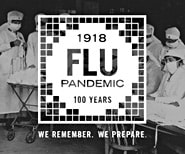Health Care Personnel Flu Vaccination, Internet Panel Survey, United States, November 2012
Updated on July 17, 2013 to reflect revised information.
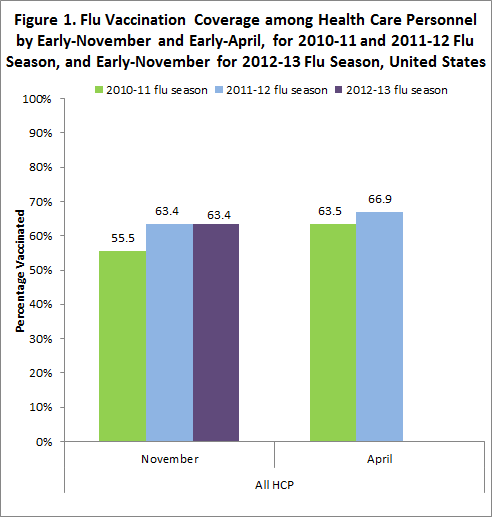
Influenza (the flu) can cause disease among health care personnel (HCP) and their patients.
- Flu vaccination has been shown to reduce the risk of flu and absenteeism in vaccinated adults and HCP vaccination in particular has been shown to reduce the risk of respiratory illness and deaths in nursing home residents (1–5).
- The Advisory Committee on Immunization Practices (ACIP) recommends that all HCP receive an annual flu vaccination (6).
- Flu vaccination coverage among HCP has improved but remains below the national Healthy People 2020external icon target for flu vaccination among HCP is 90% (7).
CDC analyzed data from an internet panel survey conducted among HCP during November 2012 to provide a timely estimate of how many HCP were getting vaccinated. The results of this survey provide information for use by vaccination campaigns during National Influenza Vaccination Week (December 2-8, 2012). This report provides early flu season estimates (early November) of vaccination coverage by HCP so far this year. Final 2012-13 flu season HCP coverage estimates will be available after the end of the season.
Key Findings
- Early-season 2012-13 flu vaccination among HCP was the same as coverage by early-season 2011-12, 63.4%.
- During the previous two seasons, flu vaccination coverage increased by 3-8% from midseason to end of the season.
- If a similar proportion is vaccinated after November this year, overall coverage will be similar to the prior year.
- During the previous two seasons, flu vaccination coverage increased by 3-8% from midseason to end of the season.
- By occupation, flu vaccination was highest among pharmacists (88.7%), physicians (85.3%), nurse practitioners/physician assistants (85.0%), nurses (79.7%), and other clinical professionals (75.5%).
- Flu vaccination was lowest among assistants or aides (46.8%) and administrative/non-clinical support staff (54.3%).
- By work setting, flu vaccination coverage was highest among HCP working in hospitals (82.5%).
- Flu vaccination was lowest among HCP working in long-term care facilities (47.9%).
- Among unvaccinated HCP who did not intend to get the flu vaccination, the most common main reason reported for not getting vaccinated was that they do not want vaccination. The second most common main reason was the belief that the vaccination was ineffective.
- Conclusion/recommendation:
- Educating HCP, especially assistants or aides and non-clinical staff, and HCP working in long-term care facilities about the importance, effectiveness, and safety of annual flu vaccination may increase overall vaccination coverage.
Who Was Vaccinated?
Sample Demographics
- A total of 2,006 HCP were included in the survey.
- By age, 1,188 (59.2%) were 18 to 49 years, 746 (37.2%) were 50-64 years, and 72 (3.6%) were 65 years and older.
- For additional occupation characteristics, please see the attached table occupation characteristics excel icon[XLSX-13K].
- For additional work setting characteristics, please see the attached table work setting characteristics excel icon[XLSX-13K].
Coverage by Occupation
- Flu vaccination coverage was higher among pharmacists (88.7%), physicians (85.3%), nurse practitioners and physician assistants (85.0%), nurses (79.7%), and other clinical professionals (75.5%) compared to assistants or aides (46.8%) and administrative/non-clinical support staff (54.3%).
- Flu vaccination coverage increased from early-season 2010-11 to early-season 2012-13, the coverage increased among physicians from 75.5% to 85.3% and among nurses from 61.5% to 79.7%.
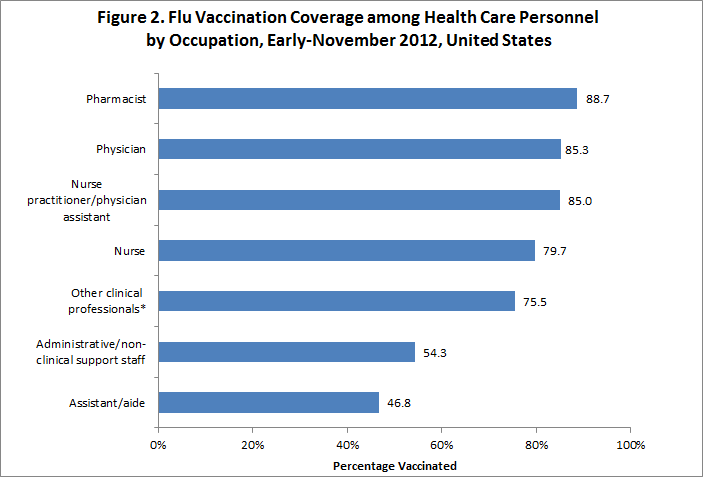
For additional occupation vaccination coverage information, please see the attached table additional occupation characteristics excel icon[XLSX-12K].
Coverage by Work Setting
- Flu vaccination coverage varied by work setting and was higher among HCP working in hospitals (82.5%) compared to other work settings and lowest among HCP working in long-term care facilities (47.9%).
- Coverage among HCP working in hospitals was higher than HCP working in other work settings in the November 2011 and November 2010 surveys.
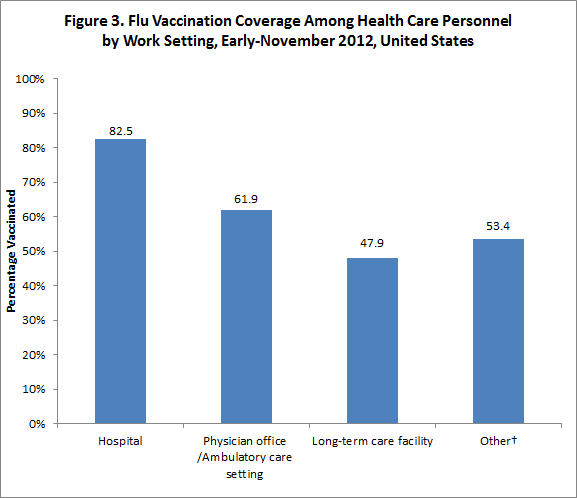
Coverage by Age Group
- Flu vaccination coverage varied by age, ranging from 60.1% in HCP 18-49 years to 70.5% in HCP 50-64 years.
- These estimates are similar to those from the November 2011 survey.
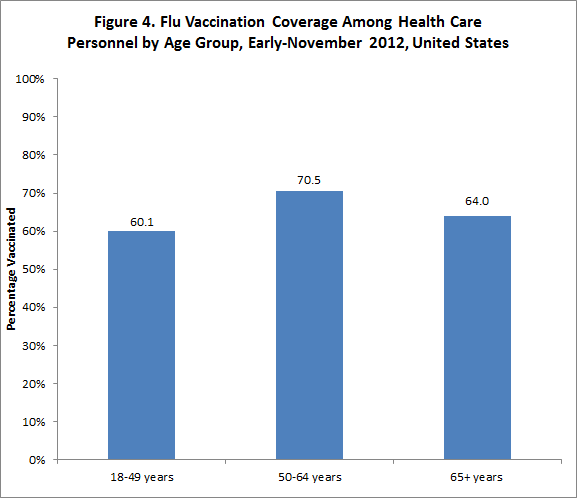
Place of Vaccination
- Similar to the past two seasons, the majority of HCP received the flu vaccination at their workplace.
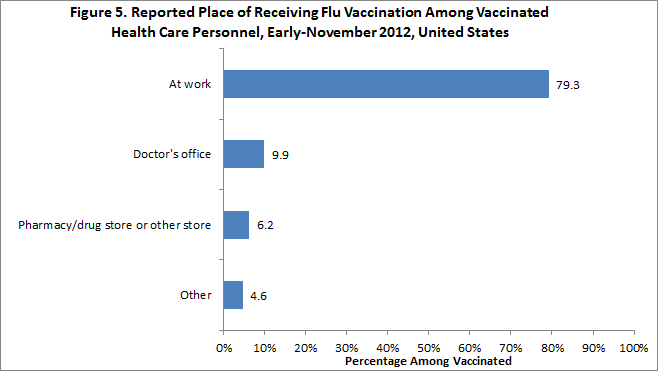
Main Reason for Receiving Vaccination
- Protecting themselves from flu was the most common main reason reported by vaccinated HCP for receiving the influenza vaccination.
- Employer requirement for flu vaccination and protecting friends, family, and patients from flu were each a commonly reported main reason why vaccinated HCP decided to get the flu vaccination.
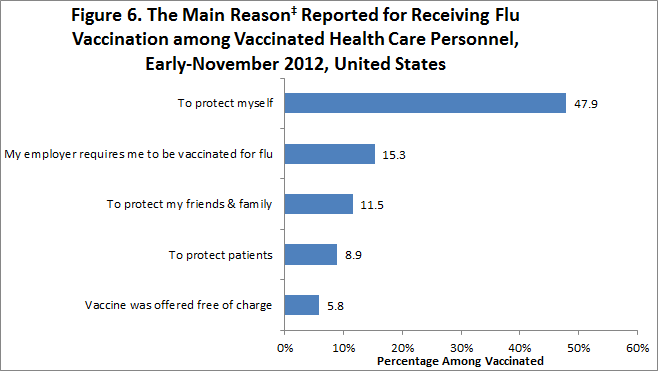
Main Reason for Not Receiving Vaccination
- Among unvaccinated HCP who reported that they did not intend to get flu vaccination this year, the most commonly reported main reason was that they do not want vaccination.
- Other reasons commonly reported as main reason included not thinking that influenza vaccinations work, not thinking that influenza vaccination was needed, fear of getting sick or side effects from vaccination, and being allergic to the vaccine.
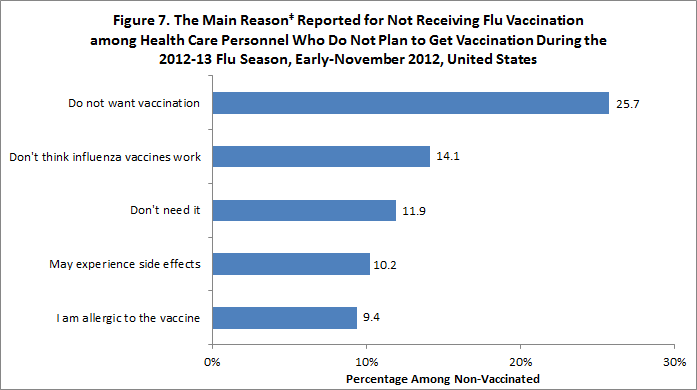
What Can Be Done? (Recommendations)
Overall the early-season estimate of flu vaccination coverage among HCP in 2012-13 was the same as early-season coverage in the prior season (63.4%). While flu vaccination coverage estimates among HCP overall working in hospital settings, and pharmacists, physicians, nurse practitioners, physician assistants, and nurses across all work settings are nearing the Healthy People 2020external icon target goal of 90%, flu vaccination coverage levels among other categories of HCP and among HCP working in long-term care facilities and other work settings remain substantially lower than other HCP groups. Clinical care groups should be commended for high vaccination levels.
Successful vaccination campaigns programs should be continued among pharmacists, physicians, nurse practitioners, physician assistants, and nurses and in hospitals and physician offices/ambulatory care settings to ensure vaccination coverage continues to improve. Additional efforts need to be focused on improving vaccination coverage among assistants or aides and administrative/non-clinical support staff and in long-term care facilities and work settings other than hospitals and physician offices/ambulatory care settings. Continued efforts are needed to ensure all HCP are vaccinated as soon as possible during this season.
- HCP education:
- Flu can spread rapidly in health care settings and vaccination is the first and most important step HCP can take to reduce their risk of getting ill from flu.
- Efforts should continue to educate HCP about the safety and effectiveness of flu vaccination and its importance to prevent flu for themselves, their friends and families, and their patients.
- Resources are available at https://www.cdc.gov/flu/professionals/vaccination/index.htm.
- HCP vaccination monitoring:
- CDC’s National Healthcare Safety Network (NHSN), a longitudinal surveillance system, has introduced a module for reporting HCP influenza vaccination at the hospital level, based on the HCP influenza vaccination measure endorsed by the National Quality Forum (10).
- Beginning in January 2013, the Centers for Medicare & Medicaid Services (CMS) will require acute care hospitals that CMS reimburses to report HCP influenza vaccination levels through NHSN as part of the Hospital Inpatient Quality Reporting Program.
- CDC’s National Healthcare Safety Network (NHSN), a longitudinal surveillance system, has introduced a module for reporting HCP influenza vaccination at the hospital level, based on the HCP influenza vaccination measure endorsed by the National Quality Forum (10).
- HCP access to vaccination:
- Previous analyses have shown that ensuring flu vaccination is free and offered on multiple days in multiple work settings is associated with the greatest improvements in HCP flu vaccination coverage (11).
The November internet panel survey of HCP is designed to provide timely estimates of national flu vaccination coverage among HCP and to assess the effectiveness of current vaccination efforts. The follow-up survey in April 2013 will provide end-of-season flu vaccination coverage estimates.
Data Source and Methods
CDC collected data from two pre-existing web-based panels from November 1-18, 2012. Clinical personnel were recruited from the membership of Medscape, a web portal managed by WebMD Professional Services, and non-clinical personnel were recruited from Survey Spot, a general population Internet panel. The sample was weighted to reflect the demographic composition of the target population of U.S. HCP. Survey items included vaccination during the current flu season and vaccination history, and knowledge, attitudes and beliefs concerning flu and vaccination. There were 2,089 health care personnel who were eligible and started for the survey and 2,006 (96%) who completed the survey. Weighted estimates were calculated based on each occupational group by age, gender, race/ethnicity, health care setting, and census region to be generalizable to the U.S. population of HCP.
Weighted analyses were conducted using SAS v9.2 survey procedure. Because the opt-in Internet panel sample is based on those who self-selected for participation in the panels rather than a random probability sample, statistical measures such as calculation of confidence intervals and tests of differences cannot be performed (12).
Limitations
These results are preliminary and should be interpreted with caution. The follow-up survey in April 2013 will allow for assessment of flu vaccination coverage at the end of the flu season. Final estimates for the 2012-13 flu season will be adjusted to account for differences in respondent characteristics that may be associated with flu vaccination coverage and may affect estimated levels of flu vaccination among different subgroups of HCP.
The findings in the report are subject to several limitations.
- The sample was not necessarily representative of the approximately 18 million HCP in the United States. The survey was conducted among a much smaller group of volunteer HCP (a nonprobability sample) who had already enrolled in Medscape or SurveySpot rather than a randomly-selected sample.
- Some bias may remain in estimates after weighting the sample to improve representativeness, given the exclusion of individuals with no internet access and the self-selection processes for entry into the panels and participation in the survey. Estimates might be biased if the selection processes for entry into the Internet panel and the decision to participate in this particular survey were related to receipt of vaccination. All vaccination results are based on self-report and are not verified by employment or medical records.
- The definition of HCP used in this Internet panel survey (persons who worked in a medical-care setting or whose work involved hands-on care of patients) might vary from definitions used in other surveys of vaccination coverage.
- Occupation categories could not always be separated because of small sample sizes and questionnaire design or other limitations.
- The 2011–12 estimates might not be directly comparable to those made for previous flu seasons using Internet survey panels and NHIS, because different methods of recruitment were used each year. Compared with the population-based estimates of NHIS, flu vaccination among HCP from the Internet panel surveys differed (63.4% versus 57.5%) for 2009–10 (9). Similar differences were observed for 2010–11 (63.5% versus 55.8%) and for 2011-12 (66.9% versus 62.4%) seasons (9–10) (CDC, unpublished data, 2012).
Despite these limitations, internet panel surveys are a useful surveillance tool for timely midseason and postseason evaluation of flu vaccination coverage and knowledge, attitude, practice, and barrier data.
Authors: Jun Zhang, MD; Gary L. Euler, DrPH; Samuel B. Graitcer, MD; Stacie Greby, DVM, MPH; Immunization Services Division, NCIRD
Related Links
- Influenza vaccination coverage: FluVaxView
- 2011-12 end-of–season MMWR
- 2011-12 early-season online report
- 2010-2011 end-of season MMWR
- 2010-2011 early-season online report pdf icon[326 KB, 5 pages]
- Flu.gov for Health Professionalsexternal icon
- Influenza Vaccination Information for Health Care Workers
- NIVW Resources for Health Professionals and Partners
- SSIexternal icon
- SurveySpotexternal icon
- Follow CDC Flu on Twitter: @CDCFlu
References/Resources
- Saxen H, Virtanen M. Randomized, placebo-controlled double blind study on the efficacy of influenza immunization on absenteeism of healthcare workers. Pediatr Infect Dis J. 1999; 18:779-783.
- Bridges CB, Thompson WW, Meltzer MI, et al. Effectiveness and cost-benefit of influenza vaccination of healthy working adults. JAMA 2000;284;1655-63.
- Oshitani H, Saito R, Seki N, et al. Influenza Vaccination Levels and Influenza-Like Illness in Long-Term–Care Facilities for Elderly People in Niigata, Japan, During an Influenza A (H3N2) Epidemic. Infect Control Hosp Epidemiol 2000;21:728-730.
- Hayword AC, Harling R, Wetten S, et al. Effectiveness of an influenza vaccine programme for care home staff to prevent death, morbidity, and health service use among residents: cluster randomised controlled trial. BMJ, doi:10.1136/bmj.39010.581354.55 (published 1 December 2006).
- Lemaitre M, Meret T, Rothan-Tondeur M, et al. Effect of influenza vaccination of nursing home staff on mortality of residents: a cluster-randomized trial. J Am Geriatr Soc. 2009; 57:1580-1586.
- CDC. Immunization of health-care personnel: recommendations of the Advisory Committee on Immunization Practices (ACIP). MMWR 2011;60(No. RR-7).
- Healthy People 2020. (Accessed November 21, 2012)
Available at http://www.healthypeople.gov/2020/topicsobjectives2020/objectiveslist.aspx?topicid=23external icon - Caban-Martinez AJ, Lee DJ, Davila EP, et al. Sustained low influenza vaccination rates in US healthcare workers. Prev Med 2010;50:210–2.
- CDC. Influenza vaccination coverage among health-care personnel—United States, 2011–12 influenza season. MMWR 2012;61: 753–7.
- APIC. CDC alert: NHSN module for HCP influenza vaccination reporting available Sept. 14. Washington, DC: APIC; 2012. Available at http://www.apic.org/for-media/news-releases/article?id=b74a94cf-72be-44e3-a594-689327df860eexternal icon. Accessed November 21, 2012.
- CDC. Influenza vaccination coverage among health-care personnel—United States, 2010–11 influenza season. MMWR 2011;60:1073–7.
- AAPOR Opt-In Surveys Report. (Accessed November 21, 2012)
Additional information available at http://www.aapor.org/opt_in_surveys_and_margin_of_error1.htmexternal icon.
Footnotes
* Included allied health professional, dentist, technician, and technologist.
† Included dental offices, pharmacies, non-hospital laboratories, medical-related schools, emergency medical technician sites, and home medical-care sites.
‡ Single top main reason.
